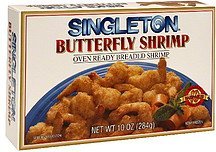Product pictures
| Amount Per 7 shrimp | |||
| Calories | 200 Kcal (837 kJ) | ||
| Calories from fat | 72 Kcal | ||
| % Daily Value* | |||
| Total Fat | 8g | 12% | |
|---|---|---|---|
| Saturated Fat | 1.5g | 8% | |
| Cholesterol | 60mg | 20% | |
| Sodium | 550mg | 23% | |
| Total Carbs | 22g | 7% | |
| Sugars | 1g | 4% | |
| Dietary Fiber | 1g | 4% | |
| Protein | 11g | 22% | |
| Vitamin C | 1.5mg | 3% | |
| Vitamin A | 0.1mg | 2% | |
| Iron | 1.2mg | 7% | |
| Calcium | 40mg | 4% | |
* Percent Daily Values are based on a 2000 calorie diet. Your daily values may be higher or lower depending on your calorie needs.
Find out how many calories should you eat.
Ingredients And Nutrition Overview
Best
choice Good
choice Poor
choice Avoid
it!
choice Good
choice Poor
choice Avoid
it!
-
WeightWatchers Points: 4.5, PointsPlus: 5, SmartPoints: 6
WeightWatchers Points are estimated by carbohydrates, fats, protein and fiber in product. They are not an affirmation of better quality or nutritional value of the product or its manufacturer. Only way to count for dieters. Less points are better.
Read more at Weight watchers diet review -
Keep an eye on the cholesterol.
Today cholesterol is no longer a villain. The 2010's USDA guidelines told us to limit cholesterol from foods
Now experts say cholesterol is "not a nutrient of concern" because cholesterol from foods doesn't cause higher blood cholesterol levels.
Nevertheless try to consume no more than 300 milligrams daily.
This product contains more than 20% of your daily cholesterol intake.
If you still are on a low cholesterol diet, please keep in mind:
- nutritionists are not recommending you go out and binge on cheeseburgers and fries.
- 10% of your daily allowance can quickly become 50% when a hamburger turns into double cheeseburger.
-
Want to lower the cholesterol intake? Here are some advices:
- Try to limit your cheese, dairy and meat intake to one item per meal.
- Avoid meals with multiple sources of cholesterol (chicken with cheese, junk food)
- Try to indclude in your diet low- or nonfat dairy, seafood, legumes and nuts.
- Choose water instead of milk for your coffee.
-
Salty! Has over 23% of the daily sodium max
The average American consumes 5,000 mg of sodium daily — twice the recommended amount amount of 2400mg for healthy adults, this is 1 teaspoon of salt.
For medical reasons many people should not exceed 1500mg of sodium.
Surprisingly, you're responsible for only 15% of the sodium in your diet the bigger part - 75% of the sodium that you consume each day comes from processed foods, not home cooking or the salt shaker.
Excess sodium intake increases the risk of high blood pressure, hypernatremia, hypertension, cardiovascular disease and other heart problems.
Are these reasons enough to cut the sodium intake? No doubt! -
Convert Salt tsps to Sodium mg easily
Salt (NaCl) is not excactly sodium (Na).
It is not right to use these terms as synonyms.
The FDA recommended limit of sodium is 2,300 mg per day (or even less - about 1500 mg while one is on low sodium diets).
This is much less than the weight of salt.
(5,750 mg per day or 3,750 mg for low sodium diet) and not so convenient to calculate.
Know how much sodium is in your salt - without a calculator:
1/4 tsp salt = 600 mg sodium
1/2 tsp salt = 1200 mg sodium
3/4 tsp salt = 1800 mg sodium
1 tsp salt = 2300 mg sodium -
Great! Contains less than 1.5 tsp of sugar.
Great! Contains less than 1.5 tsp of sugar per serving!
-
Product contains sulfites
Sulfites (sulphites) are inorganic salts that are used as antioxidant of food preservative or enhancer.
They may appear on food labels in various forms, such as: sulfur dioxide, potassium bisulfite, potassium metabisulfite, sodium bisulfite, sodium metabisulfite or sodium sulfite
Although sulphites do not cause a true allergic reaction, people with sensitivity to sulfites may experience similar reactions as those with food allergies.
Those who have asthma are most at risk to sulphite sensitivity.
BTW sulfites are included in the ten priority food allergens in Canada. -
Controversial additive BHT present
BHT (butylated hydroxytoluene) is primarily used as an antioxidant food additive, mainly to prevent oils and fats in foods from oxidizing and becoming rancid.
It is GRAS in the US, but forbidden as food additive in Japan (since 1958), Romania, Sweden, and Australia.
Some studies have shown that it is carcinogenic.
Avoid it, there are foods available without this danger.
Allergens
Shellfish Allergy, Gluten Allergy, Wheat Allergy, Corn Allergy, Lactose Allergy, Milk Allergy, Soy Allergy, Sulfites Allergy, Sesame Allergy
Butterfly shrimp Ingredients
Shrimp, Bleached Wheat Flour, Water, Modified Corn Starch, Onion Powder, Salt, Garlic Powder, Sugar, Yellow Corn Flour, Leavening (Sodium Acid Pyrophosphate, Sodium Bicarbonate), Yeast, Whey, Nonfat Milk, Dextrose, Caramel Color, Soybean Oil, Spices, Spice Extractive, Oleoresin Paprika, Sodium Tripolyphosphate (to Retain Moisture), Sodium Bisulfite (as a Preservative), Panfried In Vegetable Oil (Corn and/or Soybean and/or Canola Oil, with BHT).
You Might Also Like
% RDI of Main Nutrition Facts
10%
of RDI* (200 calories) 0 g
-
Cal: 10 %
-
Fat: 12.3 %
-
Carb: 7.3 %
-
Prot: 22 %
-
0%25%75%RDI norm*
Calories Breakdown
- Carbs (43.1%)
- Fat (35.3%)
- Protein (21.6%)
Get Your Recipe of Health!
Follow RecipeOfHealth on Facebook!











Add your comment